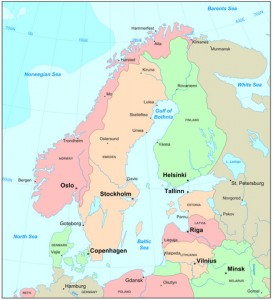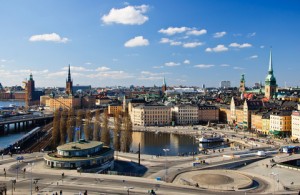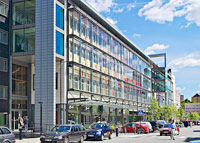
[Last updated April 2023] A guide to serviced offices and office space for rent in Stockholm as well as general information that may be useful if you are thinking of renting office space in the city.
For further offices information or to search office space for rent in Stockholm just click. Or contact us for any other query.
History & Geography
The capital of Sweden is also the most densely populated area in Scandinavia and a regional economic hub. Located on 14 separate islands on the south-central east coast of the country at the mouth of Lake Malaren, the city is perfectly strategically located. The centre of the city is on Riddarfjarden Bay and over 30 per cent of Stockholm is waterways, with another 30 per cent made up of parks. The city was founded in 1250 by Swedish nobleman Birger Jarl in order to defend the rest of Sweden from foreign fleets. It was because of the Bergslagen iron mines that Stockholm first became prominent. The city was also helped by the proximity of the Baltic Sea, and trade with the Hanseatic League of merchants operating out of Hamburg, Lubeck and other northern ports ensured the city flourished. As Sweden grew into a major European power in the 17th century, so too did Stockholm gain in importance and power. The city became the centre of the Swedish Empire and its population multiplied sixfold. However in 1710, a plague decimated the city, and with the advent of the Great Northern War, a conflict involving Sweden, Russia, Poland and Denmark, the city’s economic and population growth slowed drastically. However by the mid-19th century, the city had regained its prominence and its population swelled once more, mainly due to a high number of immigrants. In the 20th century, Stockholm continued its prosperity and became a technically advanced, modern city.
Green city
Stockholm is one of the most eco-friendly cities in the world. In 2010, the European Union Commission granted the city the European Green Capital Award, making it Europe’s first green capital. The city is surrounded by 219 nature reserves and has approximately 1,000 green spaces. Its Royal National City Park is the world’s first legally protected ‘national urban park’.
Moreover, the government set the goal of having only clean vehicles in the city by the end of 2011 and, by 2014, the city had 160,000 registered clean vehicles which was equivalent to 20% of all the vehicles registered.
It was estimated at that time that this reduced some 150,000 tons of CO2 per year.

Economy
The service industry accounts for approximately 85 per cent of jobs in Stockholm. Heavy industry and manufacturing are almost non-existent, which helps the city keep up its reputation as one of the cleanest metropolises in Europe. The tech industry is also very predominant in the city, with IBM, Ericsson and Electrolux all being major employers in Stockholm. The city is also the financial services and banking centre of the country. All the major Swedish banks have their headquarters in Stockholm, including Swedbank, Handelsbanken, and Skandinaviska Enskilda Banken. Swedish clothing giant H&M also has its headquarters in the city. In the 2000s and 2010s, tourism became a major industry in Stockholm.
Tourism
Between 1991 and 2004, overnight stays in Stockholm rose from 4 to 7.7 million with most of the city’s tourists coming from nearby Europe. Much of the appeal of Stockholm is aesthetic. With its multitude of waterways, the city has an open and healthy feel to it. The architecture of Stockholm also contributes to its popularity. The Gamla Stan area is the oldest section of the city and features a medieval street layout and several buildings from the 15th century. In the 1930s, a wave of modernism swept the city and many of its buildings are from this period. Museum-lovers will also like Stockholm, as it has more museums than almost any other city in the world. The most famous is the Nationalmuseum at Södra Blasieholmshamnen 2, which boasts 16,000 paintings and 30,000 art objects. Also worth a visit is the Royal Coin Cabinet, which tells the history of money. For food lovers, the city has over 1,000 restaurants, and due to Sweden’s high levels of immigration, almost every taste can be catered for. The city also has a lively nightlife, though alcohol is notoriously expensive, and not served to those under 20 years of age. Stureplan Square and its surroundings are the most popular nightlife destination in Stockholm, boasting a plethora of bars and clubs.
Transportation
Stockholm has a very extensive public transportation system, but visitors should bear in mind that it is among the most expensive in the world. It is mostly made up of the Stockholm Metro, the urban rail systems the Roslagsbanan and the Saltsjobanan, a tramway, and the Stockholm commuter rail. The city also has a large bus network and a boat line called the Djurgardsfarjan. All the land-based public transport in the city is handled by the Storstockholms Lokaltrafik which has a common ticket system which makes transferring between modes of transport easy. Stockholm-Arlanda Airport is the biggest and busiest in the country and is located approximately 40 kilometres from the city. An express rail link runs between the airport and the city.

Office Space in Stockholm
Like every other major city in Europe, Stockholm struggled in the wake of the global 2008 financial crisis. The rise in unemployment in the city was fairly substantial, though lower than in the rest of the country.
Despite this, by 2013, rents had fallen only slightly. There were signs of recovery in the labour market at that time, however, which also meant a rise in demand for office space.
In 2013, the office space vacancy rate in Stockholm was 12 per cent, however, this was not expected to rise significantly as a lot of unused space was being let following tenants releasing it back onto the market once the leases expired.
In the central business district, the vacancy rate was only 8 per cent. The most desired area for office space remained the so-called ‘Golden Triangle’ consisting of the Norrlandsgatan, Birger Jarlsgatan and Hamngatan roads.
Another popular area for office space was around the central train station in the west of the city. There were a plethora of newly built buildings and renovated office spaces in this area.
In 2023, following the global pandemic, Stockholm was one of the cities leading the ‘return to the office’ with its office occupancy rates close to the pre-pandemic European average of 70 per cent.
This is due to the novelty of working from home wearing somewhat thin, the desire for in-person interaction on a work and social level and, possibly, due to job insecurity following global job cuts.
Vacancy rates in the city centre are approximately 7 per cent with Stockholm’s CBD at 4 per cent. Out-of-town districts are at around 14 per cent bringing the average across Great Stockholm to 10.5 per cent.
Tenants have displayed a flight to quality over the last year with a move to smaller footprints in the central Stockholm office market which has pushed prime rental levels by approximately 6 per cent over the last 12 months.
Prime office rents in Stockholm’s CBD are currently at SEK 8500 per square metre per annum (equivalent to around £661 per square metre in April 2023).
There is a growing number of flexible workspace providers in Stockholm that provide office space solutions that are increasingly used instead of renting office space on a traditional lease.
There are local and national providers operating in the city as well as international providers such as Regus and WeWork.
These offer a variety of fully-fitted workspace solutions that are based on shorter-term occupational agreements with relatively less onerous terms and all-inclusive pricing.
Examples include private serviced office suites, managed offices and corporate coworking solutions such as company-wide desk passes.
These operators also offer hireable meeting rooms, conference rooms and other forms of on-demand collaboration spaces for in-person working.
We carry out a free office space search and our advisory and acquisition services are also free, always. Our Stockholm office space brokers and agents are globally regulated by the Royal Institution of Chartered Surveyors (RICS) ensuring the highest standards of commercial property advice and service at all times. We look forward to helping you find the best office space for rent for your business.

The Office Providers are Regulated by the Royal Institution of Chartered Surveyors (RICS)